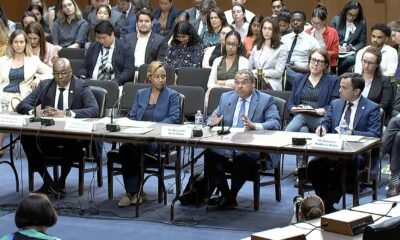Business
U.S. Economy Contracts 0.3% in Q1 Amid Trump Trade Wars Disrupting Businesses

The U.S. economy contracted at an annual rate of 0.3% from January to March, marking the first decline in three years. This drop comes in stark contrast to a 2.4% growth experienced in the preceding quarter of 2024. Disruptions from President Donald Trump’s trade policies have played a significant role in this economic downturn.
A surge in imports, driven by companies eager to stockpile foreign goods ahead of expected tariffs, contributed heavily to the decline. Imports skyrocketed at a 41% pace, the fastest since 2020, detracting 5 percentage points from overall growth. Consumer spending has also slowed sharply, decreasing to 1.8% from a robust 4% in the last quarter of 2024, while federal government spending declined by 5.1%.
Economists had predicted a modest increase of 0.8% in GDP for the quarter. Initial reports, however, shocked financial markets, leading to significant drops across major indexes; the Dow Jones Industrial Average fell 400 points shortly after the news broke.
Despite the decline, some analysts, like Paul Ashworth of Capital Economics, anticipate a rebound in the second quarter, forecasting a growth rate of 2%. The surge in imports that weighed down GDP is expected to reverse.
The mathematical interplay of trade deficits and GDP remains crucial here. Imports count against domestic production; their rise can skew GDP figures. Still, an underlying metric within the GDP data showed a healthy 3% annual rise during the same period, suggesting some economic resilience. This figure, which includes components like consumer spending and private investment while excluding volatile factors such as exports, points to a more stable economic foundation.
Nonetheless, many economists remain cautious. Trump’s volatile tariff policies may hinder growth later this year, with rising recession risks, according to Carl Weinberg of High Frequency Economics. He noted that the corrosive uncertainty surrounding tariffs could lead to negative GDP growth by year-end.
Inflation concerns are escalating as recent data revealed an annual price increase of 3.6%. The Federal Reserve’s preferred inflation measure has also risen, leading to a complex scenario for policymakers. Ryan Sweet from Oxford Economics remarked on the awkward position the Fed finds itself in, caught between supporting growth with interest rate cuts and combating rising inflation.
During Trump’s presidency, the economy experienced consistent growth despite earlier high-interest rates aimed at controlling inflation. However, the administration’s tariff strategies, including steep levies on Chinese goods, have introduced chaos into business planning and consumer pricing.
Democratic lawmakers have responded to the downturn by criticizing Trump. Massachusetts Senator Elizabeth Warren attributed the economic contraction to the administration’s erratic tariff implementation, suggesting that businesses are stockpiling imports in fear of future price hikes.
Signs of a weakening job market have also emerged. ADP reported a significant slowdown in job creation, with only 62,000 jobs added in April, far short of expectations. This decline may reflect heightened caution among businesses regarding hiring amidst ongoing economic uncertainties. Industries such as education, health, and professional services reported job cuts, further fueling concerns over labor market stability.
“Unease is the word of the day,” noted Nela Richardson, chief economist at ADP, highlighting the difficulty businesses face in making hiring decisions under current conditions.
















